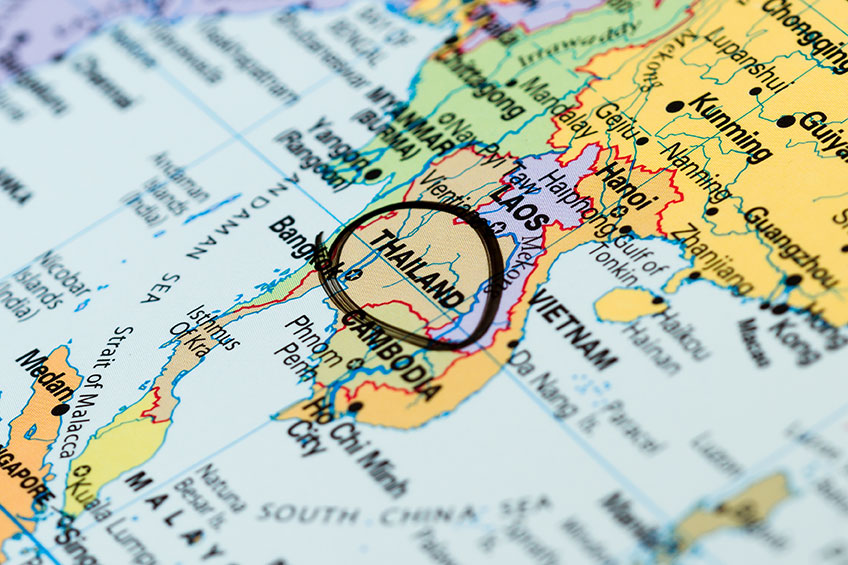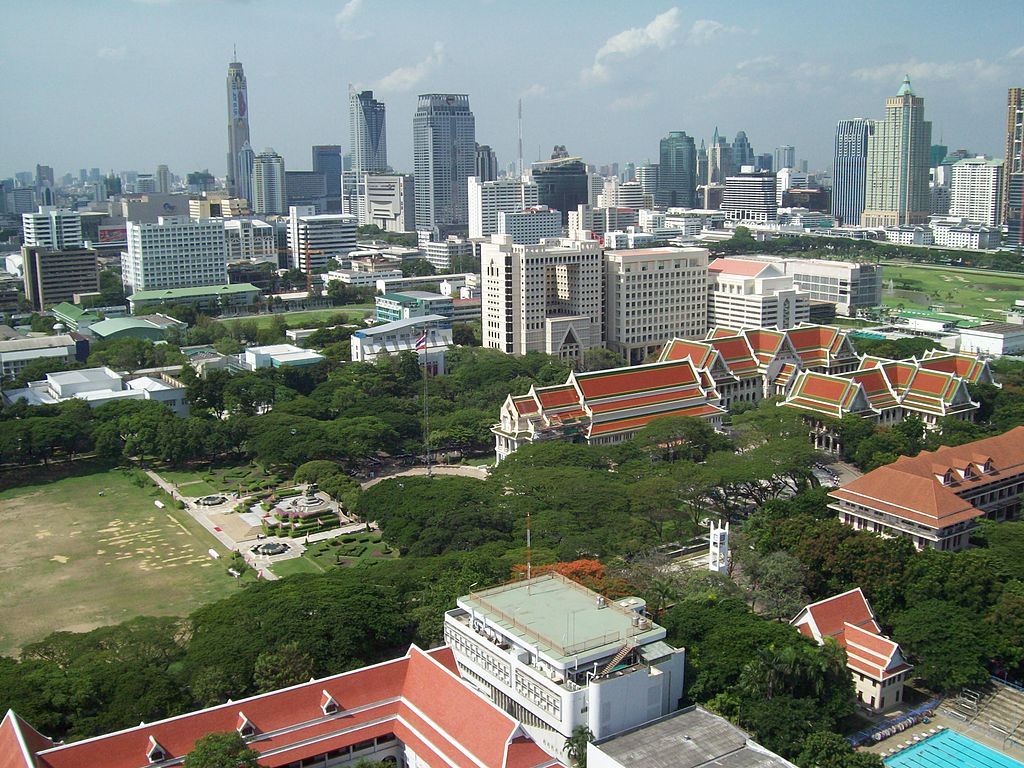
The COVID-19 pandemic has had a major impact on everyone’s lifestyle regardless of occupation. As cases accumulate worldwide, the abrupt global disruption has brought about a “new normal” lifestyle. The education sector is no exception. Educational institutions, including Chulalongkorn University in Thailand, strive for ways to proceed with classes under the challenge of this new normal lifestyle. In this essay, I will reflect on my experience with online teaching during the lockdown period in Thailand, shedding light on how the spread of COVID-19 in Thailand requires a balance between my comfort zone and the new normal way of teaching online. Arguably, online teaching during the COVID-19 pandemic is the start of a new normal education ecosystem. Conducting classes online should not feel like the end of the world, as teachers have choices in such teaching as well as the extent to which they want their classes to be online. The best option for teachers is to determine what feels comfortable for themselves and optimal for students.

A digital divide occurs when there is inequality in accessing online technology (Van Dijk 2006). This inequality arises from a lack of motivation to use online technology; lack of financial resources to buy a computer and access the Internet; lack of operational skills, information skills, or strategic skills; and lack of opportunity, obligation, time, or effort to use digital technology (Van Dijk 2006, 179–183). When classes went online in the first quarter of 2020, many of these factors might not have been an issue for university students and teachers as they were used to accessing the Internet on mobile phones and laptops as part of their lifestyle. However, access alone does not guarantee successful online classes. Successful online classes involve more than just a computer and Internet and the various skills that Van Dijk outlined to operate online technology. Being motivated and getting familiar with using online platforms to teach and learn also matter. Moreover, both teachers and students should feel comfortable with the online environment, the platform of communication. Being able to interact with students through the delivery platform is also fundamental to meeting the objectives of lectures and seminars.
In January 2020, a friend asked whether I would like to deliver the same guest lecture that I had delivered in 2019. I agreed and scheduled my class for the beginning of April 2020. While updating my teaching materials, I never realized how massively the spread of COVID-19 would disrupt the education sector. Two weeks before my lecture, I was given a choice: teach the class in person as planned, but two weeks earlier; or leave the date as scheduled but conduct the session online. Before making my decision it was necessary to consider the following: Could my teaching materials be ready for me to teach in the following few days? Was online teaching suitable to meet the objectives of my lecture? Would an online platform be the appropriate working environment for real-time online teaching and facilitate in the seminar that I had initially planned?
While Chulalongkorn University was yet to officially close and Bangkok was not yet on lockdown when my friend approached me, I booked a small meeting room in my research institute to get the lecture delivered online as previously scheduled. However, throughout February and March 2020, the university regularly made official announcements with regard to instructional management given the extraordinary circumstances due to the infection outbreak both nationally and globally. But the spread of COVID-19 in Thailand become worse in the second half of March 2020, and the university was closed. There was a “soft” lockdown in Bangkok (Bangkok Post 2020).

As mentioned by L. Lantero et al. (2020), “digitalisation is undoubtedly a central element in managing the emergency,” and the COVID-19 pandemic will probably act as an accelerator for some digitalization processes. Thus, in response to the sudden closure of university campuses and education facilities, online teaching during the pandemic in Thailand was the obvious choice for me: digitalization offers solutions for educational institutions to continue teaching, studying, and researching. With advances in technology, online classes are part of “distance learning.” They can actually benefit students in remote areas by eliminating the travel time required for them to come to class (Xu and Xu 2019).
Online teaching is flexible in terms of which platform or online tools the teacher chooses to use. The staff of Chulalongkorn University were determined to provide support to teachers and students at all levels for accessing hardware and platforms to conduct classes during the pandemic. I had to adapt to online teaching and consider which tools I would be comfortable using, which platform would be suitable for my student numbers, and which platform would be appropriate for meeting the objectives of my class. Also, how should I design the seminar discussion for students to be active as well as collaborative?
As I had never experienced teaching online nor researched online tools, I did not want to use software that I had little experience with. Although we all have to start somewhere, I did not have the courage to make my guest lecture my first online presentation. The lecture time was limited, and I would not have a second chance if things went wrong. While other lecturers in Chulalongkorn University used myCourseVille, Blackboard, Microsoft Teams, Facebook Groups, or communication systems such as Zoom, Google Meets, Facebook Live, Line Group (video call), and Skype (Pansak et al. 2020), I did not feel comfortable using them. The platforms that I felt confident using in my everyday online communication included Facebook, Line chat, and voice calls. As for teaching, I still use Microsoft PowerPoint, which I consider to be my comfort zone, for my slide presentations.
Like many other teachers, I found it a challenge to get a suitable working space for a three-hour real-time online class. With Bangkok locked down from the second half of March 2020, I decided to find a quiet environment to record my voice and slides on Microsoft PowerPoint. I planned for the first part of the lecture to last an hour. I then left a few questions for students to discuss over the phone with each other. Students were expected to reply to my Gmail address within three days. I read through their responses and gave feedback by recording my voice and slides on Microsoft PowerPoint again. As my lectures and feedback were all recorded, I listened to my recording and rerecorded the part that I thought was not very clear. Overall, with this method of teaching, giving feedback, and recording it took me more than three hours to complete the whole online guest lecture.
During the Bangkok lockdown, people around me were randomly sharing their opinion that online teaching made education look “cheap.” As my experience going through the online teaching process involved a significant amount of sacrifice and compromise with the continuous spread of COVID-19 in the country, I felt that such comments reduced the dignity of teachers and were offensive as teachers did not have a choice between online and offline teaching during this time.
As an overseas graduate, coming back to Thailand to teach and contribute to the development of the Thai education sector was a pleasure for me. However, as I decided to start my academic career as a researcher at the Institute of Asian Studies, Chulalongkorn University, my main role was to conduct research, with little expectation to teach. But after having the chance to occasionally teach after my PhD graduation, it has been a meaningful and rewarding experience to conduct original research, share knowledge, and develop Thai students’ skills. From my experience teaching in Thailand so far, I see that shifting away from the classroom to online knowledge dissemination will enable a wider spread of information to students. However, there is no way that online teaching will produce an outcome equivalent to in-person teaching in university classrooms. Still, online teaching offers value given the sudden onset and spread of COVID-19. With in-person university classes having resumed in September 2020, teachers and students should consider a blended learning system, a combination of face-to-face instruction and computer-mediated instruction (Graham 2006) that can improve pedagogy, increase access and flexibility, and increase cost-effectiveness (Graham et al. 2005). This will enable adaptation in the teaching and learning system and help educational institutions prepare for future crises like the current COVID-19 outbreak.
In conclusion, the new normal online teaching and online learning required me, as a teacher, to find my comfort zone in the education ecosystem. I had to do online teaching during the lockdown period, which was appropriate in the short term during the spread of COVID-19 in Thailand from March to June 2020. Comfort zones in the new normal style of online teaching are flexible and might vary from one teacher to another. The flexibility and variation depend on the teachers’ digital literacy, their experience in using the online platform of communication as part of their daily life, and whether they want to take a risk in initiating and trying new methods of teaching online. Regardless of the extent to which teachers get on board with finding the balance between their comfort zone and new normal online teaching, I strongly believe that the search for balance between individual teachers’ comfort zone and the new normal way of teaching online aims to enable teachers and students to perform their job while maintaining a distance from each other, so as to lower their own risk of infection and to safeguard the public health. I value online teaching during the pandemic in Thailand. At the same time, I appreciate the importance of the university being a “comfort zone,” with classrooms and lecture halls as necessary facilities for an effective learning environment for students and teachers to actively and collaboratively learn from one another.
Mukda Pratheepwatanawong
Mukda Pratheepwatanawong received her Ph.D. from The University of Nottingham, Malaysia Campus, in International Communication Studies and is currently working on a number of research projects at the Mekong Studies Center, Institute of Asian Studies, Chulalongkorn University, Thailand. Her Ph.D. research explored political communication and political public relations on social media during the 2013 Bangkok Gubernatorial Election campaign with the use of mixed methods. Currently, she is researching digital vote-canvassing networks and the use of social media for the 2019 General Election campaign in Thailand.
References:
Bangkok Post. (2020). Aswin Orders “Soft Lockdown” in Capital. March 22. https://www.bangkokpost.com/thailand/general/1883645/aswin-orders-soft-lockdown-in-capital, accessed September 29, 2020.
Bryan, A., & Volchenkova, K. 2016. Blended Learning: Definition, Models, Implications for Higher Education. Educational Sciences 8(2): 24–30.
Graham, C. R. (2006). Blended Learning Systems: Definition, Current Trends, and Future Directions. In The Handbook of Blended Learning: Global Perspectives, Local Designs, edited by Curtis J. Bonk and Charles R. Graham, pp. 3–21. San Francisco: Pfeiffer.
Graham, C .R., Allen, S., & Ure, D. (2005). Benefits and Challenges of Blended Learning Environments. In Encyclopedia of Information Science and Technology, M. Khosrow-Pour (Ed.), pp. 253–259. Hershey: Idea Group.
Lantero, L., Finocchietti, C., Garner, A., & Kahami, A. (2020). Effect of the Covid-19 on Higher Education and Recognition: Informative Note for HEIs. CIMEA. http://www.cimea.it/files/fileusers/1553_ENG_COVID19_Information_note_April_2020.pdf, accessed September 25, 2020.
Oliver, M., & Trigwell, K. (2005). Can “Blended Learning” Be Redeemed? E-Learning 2(1): 16–26.
Polsaram, P., Suwannatthachote, P., Preededilok, & Areesophonpichet, S. (2020). Guidelines for Teaching and Learning of Chulalongkorn University in the Future (แนวทางการจัดการเรียนการสอนของจุฬาลงกรณ์มหาวิทยาลัยในอนาคต). Chulalongkorn University.
Eua-arporn, B. (2020a). Chulalongkorn University Announcement on Approval or Permission for Foreign Students or Researchers to Return to Their Domicile (Dated 19 March 2020). https://www.chula.ac.th/en/news/28446/, accessed September 28, 2020.
Eua-arporn, B. 2020b. Chulalongkorn University Announcement on Guidelines for Instructional Management under an Extraordinary Circumstance as a Result of COVID-19 Infection Outbreaks (Dated 5 March 2020). https://www.chula.ac.th/en/news/27986/, accessed September 27, 2020.
Eua-arporn, B. (2020c). Chulalongkorn University Announcement on Guidelines for Instructional Management under an Extraordinary Circumstance as a Result of COVID-19 Infection Outbreaks (No. 2) (Dated 12 March 2020). https://www.chula.ac.th/en/news/28220/, accessed September 27, 2020.
Eua-arporn, B. (2020d). Chulalongkorn University Announcement on Guidelines for Instructional Management under an Extraordinary Circumstance as a Result of COVID-19 Infection Outbreaks (No. 3). https://www.chula.ac.th/en/news/28257/, accessed September 28, 2020.
Eua-arporn, B. (2020e). Chulalongkorn University Announcement on Guidelines for Staff Members during the COVID-19 Infection Outbreak. https://www.chula.ac.th/en/news/28293/, accessed September 28, 2020.
Eua-arporn, B. (2020f). Chulalongkorn University Directive No. 1745/ 2563 on Compliance with the Resolution from the Cabinet Meeting Dated 17 March 2020. https://www.chula.ac.th/en/news/28328/, accessed September 28, 2020.
Van Dijk, J. (2006). The Network Society. London: Sage.
Xu, D., & Xu, Y. 2019. The Promises and Limits of Online Higher Education: Understanding How Distance Education Affects Access, Cost, and Quality. American Enterprise Institute. https://www.aei.org/research-products/report/the-promises-and-limits-of-online-higher-education/, accessed September 20, 2020.

